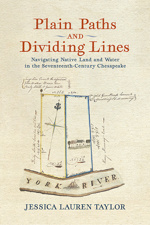Today, we are happy to bring you our conversation with Jessica Lauren Taylor, author of Plain Paths and Dividing Lines: Navigating Native Land and Water in the Seventeenth-Century Chesapeake.
What inspired you to write this book?
During my undergrad years, before finding out that I was pretty bad at the practical pieces of it, I really wanted to be an archaeologist. I loved how colors change between soil layers representing periods of occupation—the oldest artifacts which might date thousands of years into Indigenous history the deepest down, generally, and the most recent soils replete with VHS tapes and car parts nearest your feet. While I am not an archaeologist, my experiences as a student changed how I saw historical places and informed this book. Grand colonial homes, suburbs, Virginia’s roads might sit on top of, but do not cancel the existence of, Indigenous places—and were in most cases shaped by them.
What did you learn and what are you hoping readers will learn from your book?
It’s not so much a learning as an unlearning. When I started looking at sources about the Chesapeake as a graduate student, I had drilled into my mind our elementary school textbooks that showed the North American continent mapped into English, Spanish, and French zones with no Indigenous territories noted. I subconsciously accepted the present shape of the Commonwealth of Virginia as a given. I remember my advisor reading my writing and saying, “the English were this teeny, tiny presence barely clinging to the coast!!” That changed my perspective completely on the building of English fortifications and the passing fo laws regulating the movement of Native people through what was still Native land, and I saw how English authorities might be easily undermined.
What surprised you the most in the process of writing your book?
I am a public historian first, so I often get to know a little bit about a lot (Architecture on Nantucket! Home baking in Southern Virginia!) rather than a lot about a little bit (seventeenth-century English property law!). I also love working with other people building exhibits and co-teaching classes about new things. My will to write a book withered at the thought of myself, alone, writing hunched over in a dark corner somewhere. I was surprised and delighted to find that this was not solitary work at all, and even during COVID via Zoom and IG messages, I never wrote alone and continued to learn a little about a lot reading other people’s work. And, I celebrated as friends moved their own work forward.
What’s your favorite anecdote from your book?
My favorite moment involves a servant escape plot involving multiple households on the 1670s Eastern Shore, which demonstrates movement through English plantations created resistance and highlighted tenuous English control over their claimed domains. Around a dozen people were implicated in a plan to sail away from Virginia that took months to bring together, which according to court testimony revolved around the guidance of a mysterious pilot just called “Black James” and a boat belonging to a Dutch planter heavily invested in the trade with Indigenous people. While no Indigenous people are named in the plot, the economic intersections their presence created is still central to the intersections created by the opportunity and the danger posed by people in bondage to planters.
What’s next?
This question is perfectly timed. I actually just received a collaborative National Endowment for the Humanities grant, with friends at Enslaved.org and Virginia State University, to further research on bonded laborers who attempted escape in the seventeenth-century Chesapeake. My guess is that we can gain new insight into how strategies of Indigenous and African people who ran away from people who claimed their time and bodies changed (who did they run with? To where?) as racialized slavery grew in the Chesapeake, if we were able to compare cases found in county court records through a database. This also gives us a chance to provide students with a data source for classroom learning and research, especially exciting for me. Be on the lookout for more soon!





